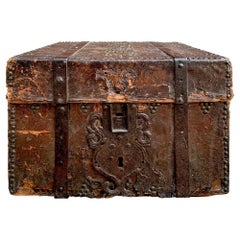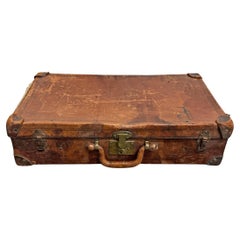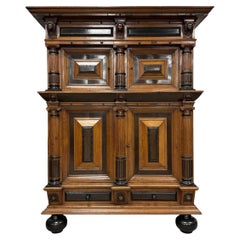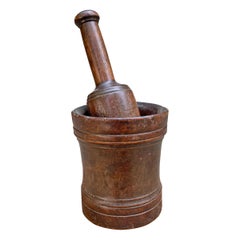Want more images or videos?
Request additional images or videos from the seller
1 of 12
17th Century Italian Leather Trunk
$2,650List Price
About the Item
- Dimensions:Height: 8 in (20.32 cm)Width: 20.5 in (52.07 cm)Depth: 14.5 in (36.83 cm)
- Style:Rustic (Of the Period)
- Materials and Techniques:
- Place of Origin:
- Period:
- Date of Manufacture:17th Century
- Condition:Wear consistent with age and use.
- Seller Location:Chicago, IL
- Reference Number:Seller: RIGHTPROPER03601stDibs: LU3738314493192
About the Seller
5.0
Platinum Seller
Premium sellers with a 4.7+ rating and 24-hour response times
Established in 2018
1stDibs seller since 2018
725 sales on 1stDibs
Typical response time: 1 hour
Authenticity Guarantee
In the unlikely event there’s an issue with an item’s authenticity, contact us within 1 year for a full refund. DetailsMoney-Back Guarantee
If your item is not as described, is damaged in transit, or does not arrive, contact us within 7 days for a full refund. Details24-Hour Cancellation
You have a 24-hour grace period in which to reconsider your purchase, with no questions asked.Vetted Professional Sellers
Our world-class sellers must adhere to strict standards for service and quality, maintaining the integrity of our listings.Price-Match Guarantee
If you find that a seller listed the same item for a lower price elsewhere, we’ll match it.Trusted Global Delivery
Our best-in-class carrier network provides specialized shipping options worldwide, including custom delivery.You May Also Like
Exceptional French 17th Century Marriage Trunk
Located in Round Top, TX
An exceptional 17th century Marriage Trunk - Malle - from the Provence region of France. Soundly constructed from wood and clad in leather. Beautifully ...
Category
Antique 17th Century French Trunks and Luggage
Materials
Leather
Italian 17th Century Primitive Collection Box
Located in Round Top, TX
A rare and unique church collection box from Northern Italy. Beautifully constructed from thick planks of walnut with intriguing carving detail. A wonde...
Category
Antique Mid-17th Century Italian Decorative Boxes
Materials
Walnut
Small 17th Century, French Coffer or Box in Leather
Located in Buisson, FR
Extremely old box that is covered with leather and metal decorations.
Rare find.
France, circa 1600-1700
Weathered and some losses.
Category
Antique 17th Century French Decorative Boxes
Materials
Leather, Wood
$943 Sale Price
49% Off
H 3.94 in W 9.06 in D 6.3 in
Boiled Leather Trunk, Spanish, 17th Century
Located in Bruxelles, BE
Leather trunk
Spanish, 17th century
Boiled Leather, wood and iron
Measures: 22 x 53 x 32 cm.
Provenance :
- collection Metz-Noblat, Château de Clevant, France
Rectangular trunk of the form and size of a small suitcase with wrought iron hinges and lock-plate.
Wood, covered with leather, cut and embossed with every surface of the thick cow hide covered in interlace, zoomorphic features.
The construction method is boiled leather, often referred to by its French translation cuir-bouilli: a process used to change flexible, vegetable-tanned leather into rigid, moulded objects. For shaping of the vegetable-tanned leather, heat and moisture were used, as indicated by the term boiled leather. No written medieval sources describing the production of decorated cuir bouilli objects survive, so knowledge of the process relies on the important studies of the Scottish leather historian John William Waterer. A large range of methods, materials and techniques could be used in various combinations. The vegetable-tanned leather, made supple with moisture and heat, was stuffed, shaped and nailed to the rigid wooden coffer support. The stuffing material was probably modeled beeswax or stearin wax. To shape the leather, to create its topography, « Cushions » were made by lacing a thread through an awl hole and attaching the flexible leather and stuffing to the rigid wooden support on the bottom. Then the decoration was done: lines were incised through the upper layer of the leather (epidermis) with different thicknesses of knives or needles. Contours were created with deep v-shaped cuts, decoration with thin incision and final details with a needle point. For the incision and pouncing stage, the leather was probably kept heated and moistened for suppleness.
Once dry, the leather would be hard and rigid.
the saturated leather is worked over a form, possibly even damp sand, with the pattern shaped using bone or wooden tools. Compare to metal, leather was lighter and it offered protection from cuts and punctures. Cuir bouilli objects were produced by specialist leather workers and needed skillful craftsmanship.
The surface is filled with roundels shaped foliages enclosing animals, lions and peacocks. The foliate arabesques creating a vegetal connection tweet the animals create the impression of a lush verdant space . The vegetal pattern here employed in combination with geometrical pattern came from the pre-islamic artistic traditions of the Byzantine and Sasanian empires. An aspect of Islamic geometry Is the basic symmetrical repetition and mirroring of the shapes that create a sense of harmony.
The decoration of this truck is inspired by the islamic « arabesque » a form of vegetal ornament composed of spirals, intertwining plants and abstract curvilinear motifs. An arabesque character is given to the birds of the decorations through extreme stylisation. This arabesque maintained the classical tradition of median symmetry, freedom in Detail and heterogeneity of ornament.
The presence of the peacocks is a paradisiacal allusion: in popular Islamic literature they were among the original inhabitants of the garden of Paradise expelled with Adam and Eve. Peacock as a decorative motif may have originated in the West, despite their eastern provenance. There was an ancient belief that the flesh and feathers of peacock do not decay. This led to the peacock becoming a christian symbol for Christ’s resurrection.
Renowned for their decorative wall hangings, seventeenth-century Spanish leatherworkers also produced utilitarian objects, such as this trunk. A similar trunk is on display at the Metropolitan museum of art ( 09.158.1).
Related literature :
Davies L. 2006. Cuir bouilli. Conservation of leather and related materials, 94-102, Oxford: elsevier Butterworth-Heinemann
Grabar, Oleg. The Mediation of Ornament. Princeton: Princeton University Press, 1992
Gabriela Germana Roquez, "El mueble en el Peru en el siglo XVIII...
Category
Antique 17th Century Decorative Boxes
Materials
Iron
$12,819 Sale Price
40% Off
Free Shipping
H 8.67 in W 20.87 in D 12.6 in
Early 17th Century Medieval Handcrafted Black Iron Coffer or Box
Located in Brescia, IT
The iron coffer, fully original in every part of it, was forged and handcrafted in German in the 1610. Complete with key. Full working iron mechanisms. It ...
Category
Antique Early 17th Century German Medieval Decorative Boxes
Materials
Iron
$18,991
Free Shipping
H 10.24 in W 15.75 in D 8.67 in
20th Century Louis Vuitton Cabin Trunk, France, c.1910
By Louis Vuitton
Located in Royal Tunbridge Wells, Kent
Around the turn of the 19th and 20th century Louis Vuitton had established himself as a market leader in trunk making and needed to set his...
Category
20th Century French Trunks and Luggage
Materials
Leather, Canvas
20th Century Louis Vuitton Malle Haute Trunk Orange "Vuittonite" Canvas, c.1900
By Louis Vuitton
Located in Royal Tunbridge Wells, Kent
A very rare Louis Vuitton “high trunk” trunk (from French “Malle Haute”), circa 1900's, features orange “Vuittonite“ canvas, all brass hardware, and leather trims. It is rare to find...
Category
20th Century French Trunks and Luggage
Materials
Brass
$20,675
H 27.96 in W 43.71 in D 24.41 in
British Campaign Royalty Leather Traveling Trunk, Circa 1820
Located in Charleston, SC
British Campaign water proof leather traveling trunk with leather fitted interior compartment, brass banding mounts, Royal coat of arms brass plate, brass side handles, and retains t...
Category
Antique 1820s English Campaign Trunks and Luggage
Marilyn Decorated Trunk
Located in West Palm Beach, FL
Wood trunk laminated with "Andy Warhol type" lithographic images on four sides & top.
Category
20th Century Decorative Boxes
Original Jewels Trunk
By Christian Dior
Located in Bois-Colombes, FR
1970s trunk covered with snake skin, marble and brass.
Category
Vintage 1970s French Boxes
Materials
Stone
More From This Seller
View All17th Century Italian Leather Box
Located in Chicago, IL
A stunning 17th century Italian leather covered wood trunk covered in brass nail heads, some spelling out a word on top, and with iron strap hinges a...
Category
Antique 17th Century Italian Baroque Decorative Boxes
Materials
Leather, Wood
19th Century English Leather Suitcase
Located in Chicago, IL
This 19th-century English leather suitcase is a charming relic of refined travel in a bygone era. Crafted from supple leather, its surface shows wear and patina that highlight its ag...
Category
Antique 19th Century English Edwardian Trunks and Luggage
Materials
Leather
17th Century Dutch Kussenkast
Located in Chicago, IL
This extraordinary 17th-century Dutch Kussenkast, or Cushion Cabinet, showcases the rich craftsmanship of the Baroque period, constructed from oak and...
Category
Antique 17th Century Dutch Baroque Cabinets
Materials
Ebony, Oak
17th Century Lignum Vitae Mortar and Pestle
Located in Chicago, IL
An incredible 17th century English mortar and pestle made from turned lignum vitae, an extremely dense hardwood found in parts of the Caribbe...
Category
Antique 17th Century British Rustic Decorative Dishes and Vide-Poche
Materials
Hardwood
Pair of 17th Century Italian Baroque Bronze Candlesticks
Located in Chicago, IL
A stunning pair of 17th century Italian Baroque bonze candlesticks with beautifully turned stems. One is a traditional candlestick that holds ...
Category
Antique 17th Century Italian Baroque Candlesticks
Materials
Bronze
Rare 17th Century Spanish Vargueño
Located in Chicago, IL
Behold a rare and remarkable treasure from 17th century Spain: the vargueño. Crafted from solid one-inch thick walnut panels, this vargueño stands as a testament to the masterful cra...
Category
Antique 17th Century Spanish Baroque Cupboards
Materials
Wrought Iron



